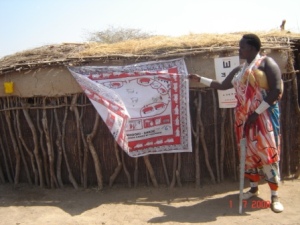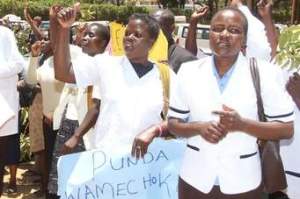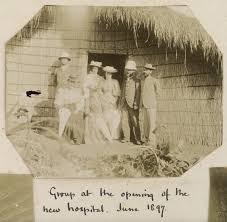Biases, distortions and patronising attitudes characterise much of the debate on Africa’s poorer performance in international health goals.
Africa’s scorecard of achievement in most health indicators and in various international health targets is nothing to shout about. At the same time, it is undeniable that biases, distortions and patronising attitudes have tended to characterise much of the debate on why it’s been this way.
A spread of daunting challenges stand in the way of effective provision of health care in African countries, some of these are linked to environmental factors- quite often facilitated by man, but others may relate to the intrinsic nature of the continent’s physical geography[i]. It has been suggested that Africa’s stride across the equator in a north-south axis may have important impacts on its topography and climate, including accommodation of nearly a third of the world’s desert land[ii]. To a considerable extent, these geographical features help explain the ecology of tropical diseases in Africa.
The sub-Saharan Africa (SSA) bears the highest burden of disease, globally.
Africa is home to several Tropical Diseases that continue to stifle its social and economic development; among these are malaria and the so-called “Neglected Tropical Diseases” (NTDs): African sleeping sickness (Trypanosomiasis), yellow fever, bilharzias (Schistosomiasis), Kala-azar (Leishmaniasis), Lymphatic filariasis, Trachoma, and (though not confined to the tropics), HIV and AIDS and tuberculosis.
The Global Burden of Disease Study 2010[iii] revealed that whereas the biggest contributor to the world’s health burden used to be the high mortality in infants and children under 5 years, now the disease burden is caused mostly by chronic diseases- cardiovascular, metabolic and musculoskeletal (arthritis) disorders, cancer, mental health conditions; and injuries. But while this is increasingly true across most regions of the world, SSA stands out as a notable exception.
In Africa, harsh environmental factors, poverty, famines and hunger, political conflict leading to internal and external displacement of persons, continue to play roles in facilitating spread of infectious diseases, childhood illnesses, and maternal causes of death, accounting for as much as 70% of the burden of disease. In addition, the region is characterised by the gross socio-economic inequalities, wide gaps between the ‘haves’ and the ‘have-nots’. The result is that African countries have to simultaneously cope with the double burden of communicable and non-communicable diseases.
Africa has been plagued by conflicts since the colonial era and continuing long thereafter. The negative effects of war on the health of populations are well documented, especially the destruction of infrastructure, and the interruption, neglect or abandonment of essential public health services. For instance, the ten-year civil war in Sierra Leone (1991 – 2002), left the health infrastructure virtually non-existent, with rates of infant and child mortality counting among the highest in contemporary world[iv]. Effects of conflict may also account for the difficulties experienced in controlling the Ebola virus disease in Sierra Leone and Liberia.
Besides mortality and morbidity, conflict has wide-ranging consequences on the health and well-being of populations, which include: rape, torture, post-traumatic stress, sexually transmitted infections (including HIV/AIDS) and long-term mental health problems.
Rapid population growth rates
Generally, rapid growth of population is associated with challenges that negatively impact on provision of health services, poverty, hunger, and inadequacies of social services and infrastructure being but a few of them. The annual Population growth rate in SSA reduced slightly from 2.8 percent in 1990 to 2.5 percent in 2010, and has sustained this rate since then. According to World Bank data, the region’s total population is projected to double by 2036. This implies diminishing opportunities and resources, particularly for the most vulnerable members of society: women, children, the poorly educated and the unemployed. It further implies more famines, exacerbated by expanding conflicts over shrinking resources.
The health care demands of a rapidly increasing population far outpace available resources, with inevitable deterioration in the quality of care that is provided. A vicious circle manifests when the underperforming health care systems minimise access to family planning services, thereby fuelling further population growth.
At the national level, rapid population growth normally translates into reduced GDP per capita. As a result, in many sub-Saharan African countries including Kenya, healthcare is predominantly funded by households through out-of-pocket spending. A household without a health insurance may be forced to pay huge medical bills for treatment of an ailing family member, exposing it to financial catastrophe and impoverishment. In 2007, about eleven percent of Kenyan households experienced catastrophic health spending, with 4 percent being impoverished. This was particularly so among the poorest households[v].
From the public health perspective, the high fertility rates that drive rapid growth of populations are also associated with high maternal morbidity and mortality rates. Pregnancies that are too close together do not allow enough time for the mother to recoup nutrients that are expended during pregnancy and breastfeeding, which may precipitate a condition referred to as maternal depletion syndrome.
Haphazard and Unrealistic planning- not addressing greatest need
The fundamental challenge facing African governments in their efforts to fulfil the mandate of providing health care for all citizens, may be traced back to the time of independence when they mostly chose to inherit the colonial, European model, of health care, where curative care was overly emphasised, while primary health care took low priority (apart from immunization to stall epidemics).

A community member explains health education message chart, Magadi, Kenya
Also perpetuated was the inequitable distribution of health facilities and services, which were predominantly sited in urban centres with little consideration for rural areas, which lacked meaningful infrastructure. It is no wonder that the World Health Organization has estimated that up to 80 percent of the populations in some African countries rely, almost entirely, on traditional systems of medicine to meet their primary health care needs[i]. In such scenario the greater majority of the population benefit little from the national health services.
The above is a clear example of planning which is not based on reality on the ground, one that does not address where the highest burden of ill-health exists. The practice of evidence based planning and priority setting which has increasingly caught up in recent years, aims to address situations such as these. Evidence based planning is particularly important where resources are limited; it is particularly important to invest in public health and health promotion strategies that are effective.
Under-resourced health care systems
Despite the Abuja pledge of 2001 to allocate at least 15% of the annual budgets to health[ii], generally, the health sector in sub-Saharan African countries remains grossly underfunded. More than a decade later, only a couple of countries can claim to have achieved the target, the majority including Kenya, are as yet to achieve the goal.
All the same, the gross amounts allocated to health have been rising in most countries. For example, between 2007 and 2011, the gross allocations to Kenya’s Ministry of Health more than doubled, from KES21.7 billion in 2007/08 to KES45.2 billion in the 2011/12 budget. But of concern is the trend in the prioritisation of health, which has not kept pace with other areas of expenditure as the economy has expanded. Over the same period, the overall gross Government expenditure rose from 353.8 billion to 815.6 billion[iii], a more than 230 percent increase. But, the share for health as a proportion of overall government expenditure declined from 6.13 percent to 5.54 percent, way below the 15% pledged in the Abuja Declaration.
Deficient budgetary allocation to health, coupled with inefficient and corrupt systems are the ultimate explanation for the disappointing performance in the public health sector, and what breeds the multitude of the perennial complaints levelled against it. More importantly, it is the root cause of denial and violations of the right to health as enshrined in national constitutions.
Human resource constraints
Efficient delivery of health care services demands availability of a viable workforce composed of well trained health professionals, and in adequate numbers. This is a prerequisite to having an effective health care system. On the other hand, most Sub-Saharan African countries continue to experience serious human resource constraints, not just with regard to doctors but also nurses and midwives, and indeed all health workers in general.
Most of them are operating with an extremely low doctor to population ratio, an average of just 1.3/10,000 compared to countries such as India (6.0/10,000), Brazil (19.2/10,000) and the United States (28.0/10,000)[iv]. In fact, some individual countries on the continent have physician to population ratios as low as 0.1-0.2/10,000. According to the World Health Organization (WHO), in order to achieve coverage of the primary healthcare needs, a country should have a minimum of 23 health workers (doctors, nurses, and midwives) per 10,000 population, a ratio few Sub-Saharan African countries can claim to possess.
For example in East Africa the country with the highest ratio of doctors, Kenya, can only claim 1.8 doctors per 10,000 people (Uganda1.2, Rwanda 0.6, Tanzania 0.1). Uganda has the highest ratio of nurse/midwives with 13.1 per 10,000 people (Kenya 7.9, Rwanda 6.9, and Tanzania 2.4). In terms of ‘health workers’ ratios Uganda leads with 14.3 per 10,000 (Kenya 9.7, Rwanda 7.5, Tanzania 2.5) [v]. Thus, none of these selected East African countries has the human resource that WHO considers prerequisite to achieving national and international health goals.
The shortage of health workers in sub-Saharan Africa is attributable to a variety of reasons, including inadequate investment in training, both pre- and in-service; internal and external migration (‘brain drain’), premature retirement, morbidity and premature mortality. In many countries the current pre-service training activities are insufficient to maintain absolute numbers even at their current levels, and mostly not enough to keep pace with population growth[vi].
Out-migration of doctors and nurses is particularly a serious drain on the economy; loss of returns from investment on their education and training has been estimated at around US$ 518,000 per doctor and US$ 339,000 per nurse[vii]. A recent survey of medical schools in sub-Saharan Africa has shown that within five years of graduation, as many as 26% of graduates had migrated out of their country – 80% emigrating outside of Africa. Of those doctors remaining at home, they were largely concentrated in urban centres, whether in public or private practice, specialist or general practitioner[viii].
There are numerous factors that drive the brain drain of health professionals. These include poor wages especially compounded by concurrent high inflation rates; poor working environment which is a common reason for job dissatisfaction; limited opportunities for self professional growth due to lack of functional facilities, equipment and supplies; and generally the lack of appreciation by the employers and the society. In some countries many of the graduating nurses may remain unemployed for years, despite the great demand for their services in public health facilities, an example of distorted prioritisation.
Corruption: the daunting challenge of combating sleaze
In most African countries, corruption has undoubtedly become the bedevilling monster behind underperformance in all development sectors, including health. The vice has been defined as abuse of entrusted power for private gain, in public and private sectors[ix]. Corruption is not just a curse in Africa; it is known to exist all over the world[x], even then, it is in Africa where the woes caused by its pervasiveness are most magnified. Corrupt practices may take varied shapes and shades, ranging from staff absenteeism, nepotism and cronyism, to irregularities in public purchasing and contracting processes, especially over-invoicing. Drugs and other items are ‘leaked’ from public health facilities to be sold privately- sometimes to patients admitted in the very same public hospitals.
The World Bank[xi] has used the term “Quiet corruption” to describe denial of public services that are due to poor people even though they are paid for. Examples of these are absenteeism among health workers, and the distribution of fake drugs while genuine ones are sold for profit.
Absenteeism occurs for various reasons, some of them legitimate or necessary, as when staff have to travel to headquarters to check why their salaries have not been paid. Staff can be absent because they are involved in personal engagements, including undertaking paid side jobs. Unfair hiring practices such as nepotism and preferential treatment to well connected individuals, promotions of undeserving staff at the recommendations of politicians, and others in positions of authority, are all expressions of corruption.
Clearly, effectively addressing corruption in African countries has become a development imperative.
An unresolved status of traditional systems of medicine
Human societies have since time immemorial, independently evolved and maintained systems of healing; Africans are not an exception. Despite efforts to suppress indigenous African medicine during the colonial era the practice still thrives throughout the continent. Traditional African medicine and African religion are intricately intertwined; illness, disease and misfortunes are understood within the context of African theology. Concepts such as these were obviously viewed as a serious threat to the work of early Christian missionaries, who preached that traditional African practices including medicine were sinful. As such, converts risked excommunication for engaging in the practice, whether as practitioners or patients.
Practitioners of western medicine have over the years, eschewed traditional African medicine dismissing its methods as primitive, superstitious and pagan. They failed to appreciate the philosophical underpinning of traditional African Medicine, in which good health, disease, success or misfortune, are seen as interrelated circumstances, which do not happen by chance but arise from actions of living individuals or ancestral spirits. Thus, traditional African medicine embraces two mutually reinforcing practices: African spirituality (divination) and herbal medicine.
In more recent years, traditional medicine has become more widely accommodated. This, in any case, was bound to happen considering that in most African countries, the penetration of ‘modern’ medicine remains such that large populations lack access to it, due to its relatively high cost and the concentration of health facilities in urban centres. As noted above, WHO’s estimates show that as much as 80% of the population in some African countries may depend on traditional medicine for their primary health care.
In fact, quite frequently, both systems of medicine (traditional and western) are used complementarily, with traditional therapies serving as a first-line treatment before modern drugs are sought. Within certain communities in Kenya, for example, majority of pregnant women will have consulted a traditional healer (mganga) who administered to them herbal preparations and potions to ward off evil spirits before making their first antenatal clinic visit[xii].
This should be strong reason why governments ought to address the unresolved status of traditional medicine, by setting up regulatory mechanisms for accommodation of the practice within the national health system. Such a measure, besides ending the unholy alliance with traditional medicine, should go a long way towards assuring safety and effectiveness of the practice.
[i] http://www.who.int/mediacentre/factsheets/2003/fs134/en/
[ii] The Abuja Declaration on HIV/AIDS, Tuberculosis and Other Related Infectious Diseases 2001
[iii] Figures based on gross approved expenditure (2007/8 – 2010/11) and gross estimates (2011/12), and indexed to inflation at 2007 CPI.
[iv] http://data.worldbank.org/indicator/SH.MED.PHYS.ZS
[v] (http://kff.org/global-indicator/physicians/, http://kff.org/global-indicator/nurses-and-midwives/)
Yohannes Kinfu, Mario R Dal Poz, et al. The health worker shortage in Africa: are enough physicians and nurses being trained? Bulletin of the World Health Organization 2009;87:225-230. doi: 10.2471/BLT.08.051599
[vii] Kirigia JM, Gbary AR, Muthuri LK, Nyoni J and Seddoh A The cost of health professionals’ brain drain in Kenya. BMC Health Serv Res. 2006; 6: 89. Published online 2006 July 17. doi: 10.1186/1472-6963-6-89 PMCID: PMC1538589 http://www.ncbi.nlm.nih.gov/pmc/articles/PMC1538589/ Accessed 28 March, 2013.
A survey of Sub-Saharan African medical schools, Human Resources for Health 2012, 10:4 doi:10.1186/1478-4491-10-4 http://www.human-resources-health.com/content/10/1/4
[ix] (http://www.transparency.org/topic/detail/health).
http://www.euro.who.int/en/data-and-evidence/evidence-informed-policy-making/publications/hen-summaries-of-network-members-reports/how-does-corruption-affect-health-care-systems,-and-how-can-regulation-tackle-it
[xi] http://www.lse.ac.uk/IDEAS/publications/ideasToday/06/worldBank.pdf
[xii]Family Care International: Care-Seeking During Pregnancy, Delivery, and the Postpartum Period: A Study in Homabay and Migori Districts, Kenya, September 2003.
[i] Jared Mason Diamond, 1999, quoted in James R. Moore, 2014, Shattering Myths about Africa: How Geography, Diseases, and Hunger Hinder Africa’s Economic and Social Development. American International Journal of Social Science Vol. 3 No. 2; March 2014. http://www.aijssnet.com/journals/Vol_3_No_2_March_2014/1.pdf
[ii]Osei, W.Y. (2010). Human-environmental impacts: Forest degradation and desertification. In S.A. Attoh (Ed.), Geography of Sub-Saharan Africa (pp. 63-90). New York: Prentice Hall.
[iii] http://www.who.int/pmnch/media/news/2012/who_burdenofdisease/en/index1.html
[iv] ‘Sierra Leone’s long recovery from the scars of war’, Bulletin of the World Health Organization: Volume 88:2010, http://www.who.int.
[v]Kimani, D. and T. Maina. 2015. Catastrophic Health Expenditures and Impoverishment in Kenya. Washington, DC: Futures Group, Health Policy Project.





